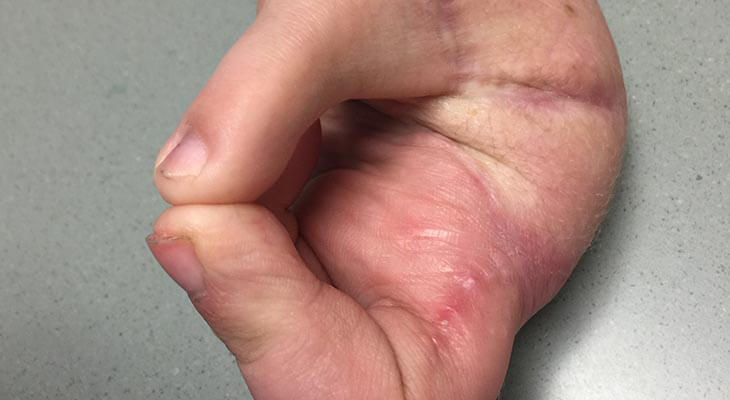

The Ile314Leu was found in 3 British families, and since my cousin and I have British parents this might be our mutation too (if our BDD is actually hereditary instead of spontaneous). The lab discovered two missense mutations in the homeodomain (Ser308Cys and Ile314Leu), but some of the type D-affected family members had type E too (in other words, additional affected fingers and/or toes besides the tip of the thumb). HOXD13 is the only gene linked to BDD so far, but the families with the mutations didn’t have “pure” BDD like Megan and me. Missense mutations probably alter the function of the protein rather than wiping it out. Those mutations may have a dominant negative or haploinsuffiency effect because the full-length protein is not in the nucleus doing its job correctly. Expansions in the poly-alanine region cause the protein to clump up in the cytoplasm, and nonsense/frameshift mutations truncate the protein. So, because Hox genes are so highly conserved across species, it’s not too surprising that mutations in HOXA13 and HOXD13 cause limb malformation syndromes in humans as well.Ī bunch of different types of mutations have been found in the human HOXD13 gene. In lab mice, genetic manipulation of the 5’ genes in clusters A and D screws up limb development, including the size, shape and number of the bones. As you would expect, the genes are all in the same order within each cluster, with A1-D1 on the 3’ end and A13-D13 on the 5’ end. The clusters originated from a quadruplication of the same initial set of 13 genes but then each cluster lost one or more genes so now no two clusters are the same. In humans, there are four homeobox gene clusters (A-D) located on 4 different chromosomes (7, 17, 12, 2). Human Hox genes only got numbers and letters.)

(Side note: If I ever write a comic book, I’m totally naming the superheroes after Drosophila Hox genes: Ultrabithorax and Antennapedia. Homeobox (Hox) genes fit the bill perfectly: transcription factors active early in embryogenesis, encoding positional information on the body axis and specifying domains in developing limbs. Obviously any BDD candidate gene would have to be important in embryonic body patterning and bone development. I must be a heterozygote, however, because my daughter’s thumbs are normal. So I suppose it’s possible that both my case and my cousin’s are coincidental new mutations. Even though my affected cousin is related on my mom’s side, our mutual grandparents and uncles aren’t affected either. In my case, neither of my parents has BDD. But, there is at least one report of a family with incomplete penetrance in a female, where an unaffected woman had a father who was bilaterally affected and a daughter and granddaughter who were unilaterally affected (on opposite thumbs, no less). The earliest reports stated that inheritance is autosomal dominant and penetrance is complete in females and incomplete in males. There are other documented instances of unilateral cases and bilateral cases within the same family. Awesome.Ībout 3/4 of BDD cases are bilateral, but it can be unilateral – one of my cousins has a unilateral case, with one affected and one normal thumb (hi cuz!). Another one from the Journal of Heredity (1934) could be from Maleficient’s Top 10 List of Curses: “Four generations of short thumbs.” In Japan, this brachydactyly is not rare, and is called Mamushi-yubi (a viper) or Shamoji-yubi (a flat rice paddle used in Japanese cooking).

The first clinical descriptions of BDD came out nearly a century ago, in 19. Oh yeah, and in case you were wondering why I was so interested… I have them too.īrachydactyly just means “short digits.” There are multiple types which can be classified based on which fingers and/or toes are affected, how severely they are affected, and whether it is part of a larger syndrome or not. Thanks to the internet trolls and some googling, I learned that the technical term for poor Megan’s heinous thumbs is Brachydactyly type D (BDD) : “short and broad terminal flanges of the thumbs.” Also – inexplicably – “murderer’s thumb.” Among the less-flattering descriptions are “clubbed thumb,” “toe thumb,” “potter’s thumb,” and if we want to get all mean-kid about it, strange, stubby and freakish. The coolest term to describe it is “digital clubbing,” which sounds like some sort of virtual-world online rave. Why? What could be so awful, so offensive, so downright ugly that the ad agency had to use a thumb-double (the first and only time I ever want to hear that phrase). Nobody even remembers what the commercial was for… (a Motorola phone, fwiw)Īnyway, there was a little social media fracas after it aired because various internet trolls noticed that a hand model had been used in the close-ups to hold the product.Īpparently the super-sexy starlet’s hands were deemed too unlovely for prime time. So why were the internet trolls so busy looking at her thumbs?


 0 kommentar(er)
0 kommentar(er)
